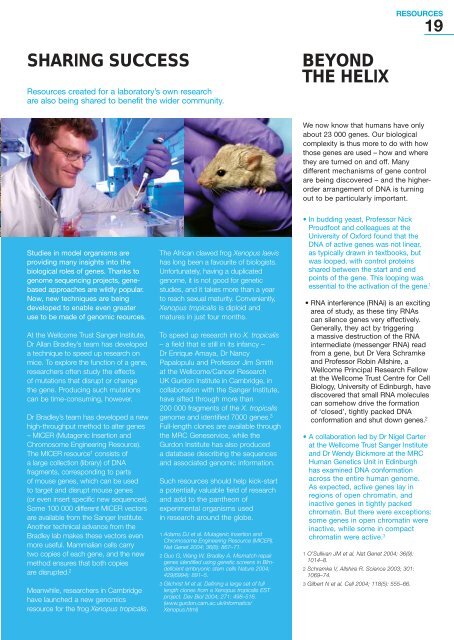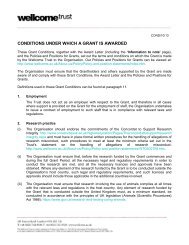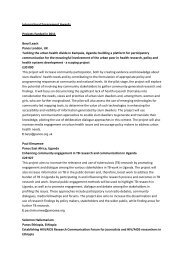Create successful ePaper yourself
Turn your PDF publications into a flip-book with our unique Google optimized e-Paper software.
RESOURCES19SHARING SUCCESSResources created for a laboratory’s own researchare also being shared to benefit the wider community.BEYONDTHE HELIXWe now know that humans have onlyabout 23 000 genes. Our biologicalcomplexity is thus more to do with howthose genes are used – how and wherethey are turned on and off. Manydifferent mechanisms of gene controlare being discovered – and the higherorderarrangement of DNA is turningout to be particularly important.Studies in model organisms areproviding many insights into thebiological roles of genes. Thanks togenome sequencing projects, genebasedapproaches are wildly popular.Now, new techniques are beingdeveloped to enable even greateruse to be made of genomic reources.At the <strong>Wellcome</strong> <strong>Trust</strong> Sanger Institute,Dr Allan Bradley’s team has developeda technique to speed up research onmice. To explore the function of a gene,researchers often study the effectsof mutations that disrupt or changethe gene. Producing such mutationscan be time-consuming, however.Dr Bradley’s team has developed a newhigh-throughput method to alter genes– MICER (Mutagenic Insertion andChromosome Engineering Resource).The MICER resource 1 consists ofa large collection (library) of DNAfragments, corresponding to partsof mouse genes, which can be usedto target and disrupt mouse genes(or even insert specific new sequences).Some 100 000 different MICER vectorsare available from the Sanger Institute.Another technical advance from theBradley lab makes these vectors evenmore useful. Mammalian cells carrytwo copies of each gene, and the newmethod ensures that both copiesare disrupted. 2Meanwhile, researchers in Cambridgehave launched a new genomicsresource for the frog Xenopus tropicalis.The African clawed frog Xenopus laevishas long been a favourite of biologists.Unfortunately, having a duplicatedgenome, it is not good for geneticstudies, and it takes more than a yearto reach sexual maturity. Conveniently,Xenopus tropicalis is diploid andmatures in just four months.To speed up research into X. tropicalis– a field that is still in its infancy –Dr Enrique Amaya, Dr NancyPapalopulu and Professor Jim Smithat the <strong>Wellcome</strong>/Cancer ResearchUK Gurdon Institute in Cambridge, incollaboration with the Sanger Institute,have sifted through more than200 000 fragments of the X. tropicalisgenome and identified 7000 genes. 3Full-length clones are available throughthe MRC Geneservice, while theGurdon Institute has also produceda database describing the sequencesand associated genomic information.Such resources should help kick-starta potentially valuable field of researchand add to the pantheon ofexperimental organisms usedin research around the globe.1 Adams DJ et al. Mutagenic Insertion andChromosome Engineering Resource (MICER).Nat Genet <strong>2004</strong>; 36(8): 867–71.2 Guo G, Wang W, Bradley A. Mismatch repairgenes identified using genetic screens in Blmdeficientembryonic stem cells Nature <strong>2004</strong>;429(6994): 891–5.3 Gilchrist M et al. Defining a large set of fulllength clones from a Xenopus tropicalis ESTproject. Dev Biol <strong>2004</strong>; 271: 498–516.(www.gurdon.cam.ac.uk/informatics/Xenopus.html)• In budding yeast, Professor NickProudfoot and colleagues at theUniversity of Oxford found that theDNA of active genes was not linear,as typically drawn in textbooks, butwas looped, with control proteinsshared between the start and endpoints of the gene. This looping wasessential to the activation of the gene. 1• RNA interference (RNAi) is an excitingarea of study, as these tiny RNAscan silence genes very effectively.Generally, they act by triggeringa massive destruction of the RNAintermediate (messenger RNA) readfrom a gene, but Dr Vera Schramkeand Professor Robin Allshire, a<strong>Wellcome</strong> Principal Research Fellowat the <strong>Wellcome</strong> <strong>Trust</strong> Centre for CellBiology, University of Edinburgh, havediscovered that small RNA moleculescan somehow drive the formationof ‘closed’, tightly packed DNAconformation and shut down genes. 2• A collaboration led by Dr Nigel Carterat the <strong>Wellcome</strong> <strong>Trust</strong> Sanger Instituteand Dr Wendy Bickmore at the MRCHuman Genetics Unit in Edinburghhas examined DNA conformationacross the entire human genome.As expected, active genes lay inregions of open chromatin, andinactive genes in tightly packedchromatin. But there were exceptions:some genes in open chromatin wereinactive, while some in compactchromatin were active. 31 O’Sullivan JM et al. Nat Genet <strong>2004</strong>; 36(9):1014–8.2 Schramke V, Allshire R. Science 2003; 301:1069–74.3 Gilbert N et al. Cell <strong>2004</strong>; 118(5): 555–66.
















